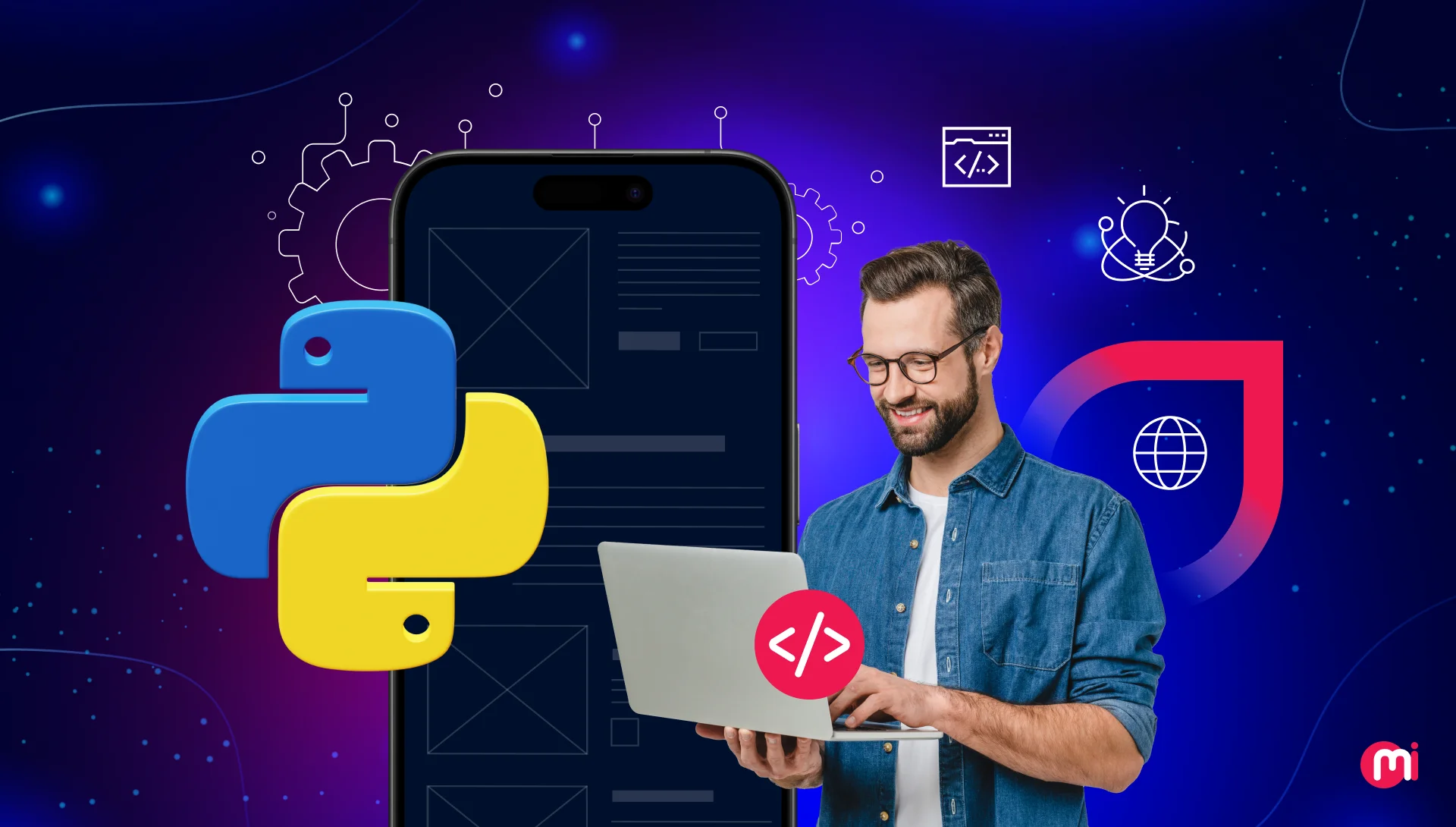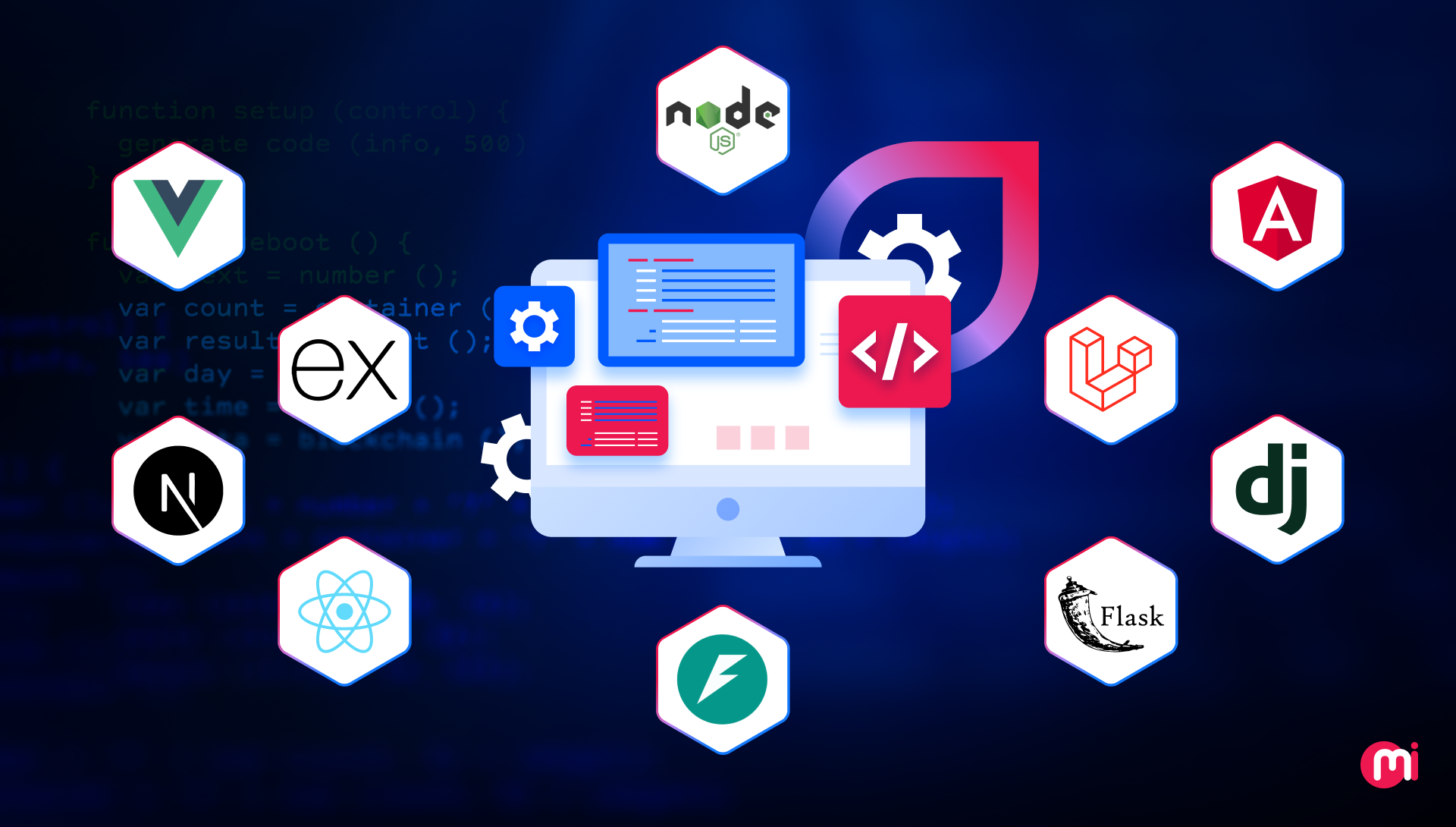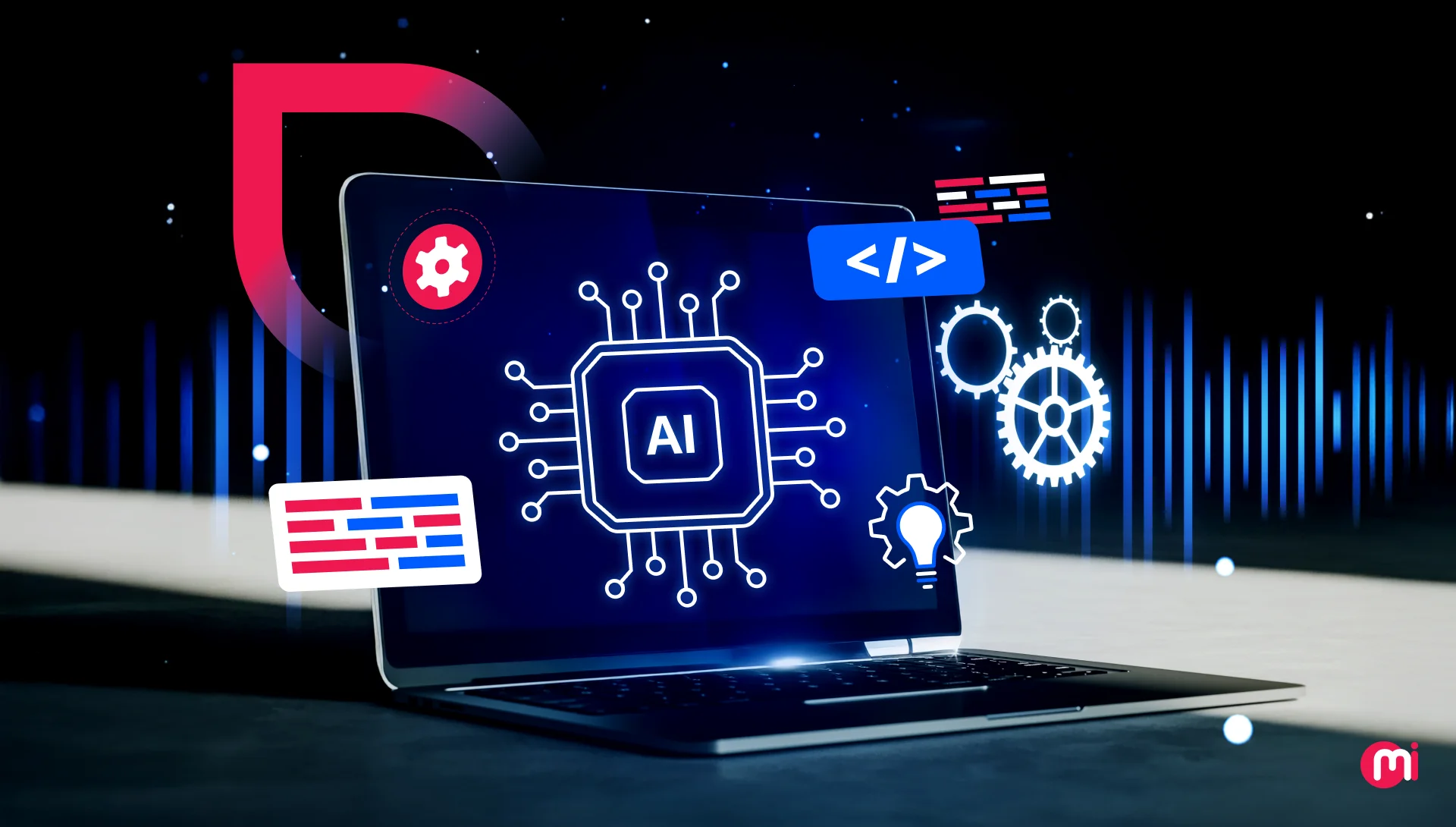Step-by-Step Guide to Python App Development with Examples
- Web
- October 3, 2025
Python has become a leading choice for enterprises and startups looking to build scalable, high-performance applications. With 22% of technology teams relying on it for faster prototyping and robust scaling, Python is becoming as an ideal technology for businesses aiming to future-proof their technology stack.
However, to make the most of Python app development services, it’s a must for tech decision-makers to deeply understand Python’s advantages, frameworks, and deployment options.
This guide provides a strategic overview of Python for app development, covering key benefits, development roadmap, framework selection, and more.
Key Takeaways
- Python is a top choice for app development, enabling scalable, high-performance applications across industries.
- Its extensive frameworks and libraries accelerate development while reducing time-to-market and costs.
- Selecting the right framework, such as Django, Flask, or FastAPI, aligns app architecture with business goals.
- Python supports modern enterprise needs, including cloud integration, microservices, and AI/ML capabilities.
- Businesses leveraging Python strategically can innovate faster and stay competitive in a rapidly evolving tech landscape
Why Choose Python for App Development?
Many tech leaders consider Python a compelling choice for app development because of its simplicity, readability, extensive libraries and frameworks, versatility and flexibility, rapid prototyping, strong community support, and scalability.
Let’s take a look at the key advantages of choosing Python for app development:
- Accelerates app development and time-to-market with its clean syntax and extensive libraries.
- Enables building scalable and high-performance applications by supporting microservices architecture, cloud-native deployment, and asynchronous programming.
- Offers a robust ecosystem and frameworks, such as Django, Flask, FastAPI, and PyQt, making it ideal for desktop, web, and mobile application development.
- Applications built using it support various operating systems (Windows, macOS, Linux, etc.) with minimal or no code changes.
- Future-proof and flexible programming language that can easily integrate with AI/ML tools, cloud services, and serverless architectures.
- Offers strong security and maintainability if the application is developed by following its best practices.
- Has a large and active community, providing abundant resources, documentation, and support for developers facing challenges.
Also Read: Why Choose Python for Software Development?
Key Features of Python for App Development
Python’s key features include object-oriented programming, modular development, dynamic typing and memory management, and an open-source programming language.
Let’s know more about the key features of Python that make it ideal for app development projects:
- Object-oriented and modular, allowing developers to structure code into reusable modules, and hence, making it ideal for large-scale apps.
- Supports dynamic typing and memory management, which accelerates development and reduces runtime errors.
- Has a rich standard library for file handling, networking, data interaction, encryption, and more, which reduces the need to build functionality from scratch, leading to time savings.
- Integrates seamlessly with other languages, APIs, cloud services, and databases, making it flexible for a complex enterprise ecosystem.
- Has built-in tools and libraries like unittest, pytest, and logging, which enable robust testing, error tracking, and code maintainability.
- Supports asyncio and asynchronous frameworks, helping apps handle high concurrency and real-time data efficiently.
- Open-source and extensible, making it a developer-friendly programming language that enables them to leverage third-party libraries, contribute extensions, and access a vast global support community.
Types of Apps That Can Be Developed Using Python
Python’s versatility allows for the development of a wide array of applications, such as web apps, data science and ML apps, desktop GUI apps, apps supporting automation, and more.
Here are some key types of applications you can build leveraging Python:
Web Application
Leveraging frameworks like Django, Flask, or FastAPI, Python can help build scalable, secure web app solutions. You should consider Python to develop your web application, as it offers rapid development with clean architecture (MVC). Not just that, with Python, it becomes easy to create and integrate APIs and databases with web apps.
As a result, you can achieve faster time-to-market and easy maintainability even for your enterprise-grade applications.
Examples: Instagram, Spotify, Pinterest, Reddit, and Quora.
Data Science and Machine Learning Application
Python is a cornerstone of data science and machine learning solutions due to its rich ecosystem of libraries. It includes Pandas, NumPy, SciPy, Scikit-learn, TensorFlow, PyTorch, and other frameworks and libraries, which help it build applications that integrate with analytics, ML, and AI models, and predictive systems.
Through this, it helps businesses to reap benefits from data-driven decision-making, predictive analytics, and intelligent automation.
Example: Netflix’s recommendations system
Desktop GUI Application
Python can be used to create cross-platform desktop applications with graphical user interfaces that are intuitive without relying on multiple languages. Its frameworks, like PyQt, Tkinter, and Kivy, support this use case.
Many businesses consider Python for desktop GUI application development because of Python’s rapid prototyping capabilities for enterprise tools and customer-facing apps.
Example: Dropbox and GIMP
Scientific and Numerical Computing
Python is widely adopted in scientific research and engineering for numerical computations, data analysis, and simulations. It’s libraries like NumPy, SciPy, and Matplotlib, and platforms like Jupyter notebooks, that empower it to fuel simulations, modeling, and numerical analysis.
Tech decision-makers consider Python for engineering, R&D, computational tasks, and financial modeling because of its precision and scientific library support.
Examples: NASA’s scientific data analysis, financial modeling tools, and physics simulations using libraries like SciPy and NumPy.
Automation and Scripting
Python’s simplicity, wide OS support, and rich built-in modules and libraries make it ideal for automation tasks, scripting, and DevOps. It can also help in data extraction, ETL processes, and system administration. Developers prefer Python for this, as it helps to save time, reduce errors, and improve operational efficiency.
Examples: Automated system administration tasks, web scraping (e.g., for data collection), and network configuration automation.
Enterprise Applications
Python is used to develop various enterprise-level applications, including ERP systems, CRM solutions, HRMS, e-commerce platforms, supply chain systems, and business intelligence tools. It works well with frameworks, like Tryton, Django, or custom-built stacks, when leveraging it in enterprise app development services.
Its flexibility in application customization, scalability, and ease of integration makes it an ideal candidate for building large-scale, mission-critical applications.
So, leveraging Python, enterprises can streamline processes, unify data, and gain long-term flexibility without being tied to rigid off-the-shelf software.
Example: Odoo (ERP system), custom business intelligence dashboards.

Game Development
While not as prevalent as C++ for high-performance games, Python is used for game logic, scripting, and developing simpler games. Its libraries, like Pygame, and engines, like Godot (via Python bindings), empower it to contribute to game prototyping and development services.
Not just that, Python is also a good fit for 2D games, educational tools, gamification features, and simulations like digital twin development solutions.
Examples: Civilization IV and Battlefield 2 (scripting)
Embedded System and IoT Programming
Python can be used to program embedded systems and Internet of Things (IoT) devices, especially for prototyping and less resource-intensive applications. MicroPython, CircuitPython, or Raspberry Pi Python libraries can help to control hardware and IoT devices. Python simplifies embedded programming and rapid prototyping on microcontrollers.
Examples: Raspberry Pi projects, home automation systems.
Top Python Frameworks for App Development
Python has various frameworks suitable for different types of applications, and some of its popular ones include Django, Flask, FastAPI, Kivy, BeeWare, PyQt, and Tkinter.
When it comes to Python app development, the choice of framework can determine how quickly you launch, how well your app scales, and how cost-efficient maintenance will be.
Let’s break down the most popular frameworks and where they shine.

1. Django
Framework Type: Web app framework
If you’re looking to build an enterprise-grade, secure, and scalable web application, Django is often the first choice. It’s a batteries-included framework, meaning it comes with everything from authentication to ORM and an admin dashboard built in.
Hence, it becomes a great option for businesses that want faster time-to-market without compromising on security or performance.
All you need is to hire Django developers who can match your project requirements.
Tech giants like Instagram and Pinterest run on Django, proving its ability to handle millions of users seamlessly.
2. Flask
Framework Type: Web app framework
Flask offers a lightweight, flexible foundation for building apps. Think of it as Django’s minimalistic cousin. It doesn’t force a specific architecture and gives you the freedom to plug in only what you need.
Hence, it becomes a perfect pick for startups exploring MVP development and microservices architecture-based applications. If you’re experimenting with new ideas, Flask helps you validate quickly without heavy upfront investment.
Hire the best Flask developers to make the most out of the freedom that Flask gives.
3. FastAPI
Framework Type: Web app framework
As applications move toward real-time, data-driven experiences, FastAPI is gaining rapid popularity. It’s designed for speed, supports asynchronous programming, and auto-generates interactive API docs (a blessing for developers).
Companies building AI/ML-powered apps, IoT platforms, or API-first products often turn to FastAPI for its ability to handle thousands of requests per second with minimal overhead. It’s modern, future-ready, and highly attractive for teams planning long-term scalability.
Hire FastAPI developers for your data-driven web app development.
4. PyQt
Framework Type: Desktop app framework
When you need a sophisticated desktop application with a polished interface, PyQt is the go-to. It provides a wide range of pre-built widgets and mimics native desktop experiences across Windows, macOS, and Linux.
Enterprises use PyQt to build internal dashboards, analytics tools, and customer-facing desktop software where a professional look and reliability are non-negotiable.
5. Tkinter
Framework Type: Desktop app framework
Tkinter is the default GUI toolkit bundled with Python. It’s not flashy, but it gets the job done for simple apps. Businesses often use it for quick prototypes, internal utilities, or training tools. Since it’s built into Python, you can spin up a GUI without installing extra dependencies, and that too at speed.
6. Kivy
Framework Type: Mobile app framework
For businesses that want to test or deploy mobile apps quickly, Kivy offers a cross-platform framework that runs on Android, iOS, Windows, Linux, and macOS. It supports multitouch interfaces and leverages OpenGL for graphics, making it great for interactive applications, educational tools, or lightweight enterprise apps.
7. BeeWare
Framework Type: Mobile app framework
In cross-platform app development services, BeeWare is the best programming tool. It allows you to write an app in Python and then deploy it natively on mobile, desktop, and even the web. Just like React Native and Flutter, BeeWare is a cost-saver for businesses targeting multiple platforms that share the same codebase. But here’s the thing: it is still maturing.
Hence, it becomes a great and forward-looking choice for startups and enterprises, valuing code reusability and multi-device reach.
A Step-by-Step Python App Development Process
Developing applications using Python involves several steps and choices depending on the type of application being built (web, desktop, or mobile). Some of the key steps involve defining the app’s purpose and requirements, choosing the right Python tool stack, designing the architecture, implementing the application, testing it across different conditions, and deploying.
Let’s have a look at the steps to build apps using Python:
STEP 1: Define App’s Purpose and Requirements
Clearly articulate your Python app development project by identifying:
- Types of applications you want to develop
- How your application should work
- What challenges should it solve
- Audience it would be targeting
- Needs and expectations of the targeted audience
- Features and functionalities that can help the application work in that way
STEP 2: Design the Application
Now, translate app ideas into a tangible design that guides development. So, first create UX wireframes by mapping out the user journey and key application flows. This will help stakeholders visualize how users will interact with the system before any code is written.
STEP 3: Create Python App Architecture
Once placements and the user journey are mapped, create a high-level architecture diagram showcasing how different services, databases, APIs, and third-party integrations will connect.
Along with that, design a data model and establish API contracts using standards like OpenAPI or GraphQL schemas while ensuring teams work against the same specifications from day one.
At this stage, you also account for failure scenarios, observability, and recovery strategies. For example,
- What happens if a service goes down?
- How do you monitor performance bottlenecks?
- Can you roll back without disrupting users?
Thinking about these questions early saves costly rework later.
STEP 4: Choose the Right Framework/Libraries
Map your application’s feature needs, technical requirements, and framework fit with the app concept and Python.
You can follow this rule of thumb for the Python framework and library selection:
| App Requirements | Python Frameworks or Libraries to Select |
| API-first, high-throughput apps | FastAPI |
| Full-stack, enterprise web apps | Django |
| Lightweight services or app prototypes | Flask |
| Desktop GUI apps | PyQT or Tkinter |
| Cross-platform apps | Kivy or BeeWare |
| Data Science/Machine Learning | NumPy, Pandas, Scikit-learn, or TensorFlow. |
STEP 6: Develop the Application
Set up the Python development environment by installing Python, creating a virtual environment, and installing necessary libraries and frameworks using pip.
Then, write the Python code to implement the defined features and functionalities. It’s a must to follow Python coding best practices, like modularity, readability, and error handling, to leave no loopholes behind.
Following the same, implement the user interface using the chosen framework and necessary libraries.
STEP 7: Test the Application
After developing the build, it’s time to conduct the layered testing to reduce production risk. You should write unit tests and integration tests to ensure individual components and the overall application function correctly. After this, you can perform thorough testing to identify and fix bugs.
STEP 8: Deploy the Application
Now, you have the green light to move the application from development to production. Focus on deploying the application safely and reliably while ensuring there are clear rollback options at every stage.
Here are app-type-based deployment options:
- Web Applications: Deploy to a cloud platform (e.g., Google App Engine, AWS, or Heroku) or a self-hosted server.
- Desktop Applications: Package your application into an executable installer for the target operating system.
- Mobile Applications: Package for Android (APK) or iOS (IPA) and distribute through app stores or direct installation.
To minimize risk, use deployment strategies such as Blue/Green or Canary releases. Ensure each deployment step is controlled and monitored to maintain reliability.
A CI/CD pipeline automates building, testing, and deploying your app, including zero-downtime database updates. Tools like Prometheus, Grafana, ELK, and Sentry monitor performance, track errors, and alert your team.
Post deployment, you can continuously monitor app performance and user feedback, address bugs, and release updates as needed. Here, the update also includes adding new features based on user requirements or evolving needs.
Common Challenges in Developing Apps Using Python and How to Overcome Them
Even though Python is versatile and powerful, app development comes with its own set of challenges, including performance bottlenecks, global interpreter lock (GIL), dependency management and environment setup, scalability and database performance, mobile app development limitations, and more.
Let’s have a look at common challenges you can face while developing apps using Python and effective strategies to overcome them:
Performance Limitations
Python’s interpreted nature can lead to slower execution speeds compared to compiled languages, especially for CPU-intensive tasks or large-scale data processing.
SOLUTION:
- Use Cython or Numba to speed up critical sections of code.
- Implement asynchronous programming with asyncio or FastAPI for high-concurrency apps.
- Optimize algorithms and avoid unnecessary loops or redundant operations.
Global Interpreter Lock (GIL)
The GIL in CPython prevents multiple threads from executing Python bytecode concurrently. This can limit true parallelism for CPU-bound tasks.
SOLUTION:
- For CPU-bound tasks, use the multiprocessing module to spawn separate processes, each with its own GIL, which will enable true parallelism.
- For I/O-bound tasks, you can use asyncio or threading.
Dependency Management and Environment Setup
Complex apps rely on multiple libraries. This can make managing various library versions, resolving dependency conflicts, and ensuring consistent environments across development and deployment complex.
SOLUTION:
- Use Poetry or Pipenv to manage dependencies and virtual environments.
- Lock package versions and regularly audit for vulnerabilities.
- Automate environment setup with Docker or containerized dev environments.
Scalability and Database Performance
As the Python application scales, handling large datasets and high traffic, it can overwhelm databases and slow down the app. In the worst case, it can even make database interactions a bottleneck.
SOLUTION:
- Use caching, indexing, and query optimization.
- Choose the right database type (SQL vs. NoSQL) based on your use case.
- Consider sharding or database replication for large-scale apps.
Mobile App Development Limitations
Python isn’t a native mobile development language and is less mature to use for the same compared to languages like Kotlin, Swift, Flutter, or React Native. Hence, mobile apps developed using Python can face performance or UI limitations.
SOLUTION:
- Use Kivy or BeeWare for cross-platform apps.
- For performance-critical mobile apps, consider hybrid approaches (Python backend + native frontend).
Debugging and Error Handling
Python supports dynamic typing and flexible syntax, which can make development easy. However, as the app grows and becomes complex, it becomes hard to identify and resolve errors (runtime specifically), making the task time-consuming.
SOLUTION:
- Implement logging, unit tests, and exception handling.
- Use debugging tools like pdb, PyCharm, or VS Code Debugger.
- Enforce code reviews and static analysis to catch issues early.
Code Maintainability and Collaboration
Large Python projects can become hard to maintain if coding standards aren’t enforced, especially with multiple developers.
SOLUTION:
- Follow PEP 8 coding standards and use linters/formatters (flake8, black).
- Use modular architecture and clear documentation.
- Enforce code reviews and CI/CD pipelines for consistent quality.
Popular Apps Built Using Python
Python is a versatile programming language used in a vast array of applications across various industries. Some of the popular apps built using Python include Reddit, Instagram, Netflix, Dropbox, Quora, and many others.
Let’s have a look at how these popular apps have utilized Python for maximum benefits:

Originally written in Lisp, Reddit, a proprietary social news aggregation and forum-based social media platform, was rewritten in Python using the web.py framework. The reason behind this tech modernization is to benefit from Python’s simplicity and clarity, faster backend development, managing millions of community threads, and scaling features without slowing down.
Instagram – a social networking app owned by Meta Platform’s backend is heavily built using Python, specifically leveraging the Django web framework. Instagram boasts one of the world’s largest deployments of Django, a Python-based framework known for its simplicity and practicality.
They chose Django for its backend to leverage its clean architecture, supporting rapid innovation, easy scalability, and consistent performance for millions of daily photo/video uploads.
Netflix
Netflix, one of the largest on-demand OTT streaming platforms, extensively utilizes Python across various aspects of its infrastructure and services. Python at Netflix powers machine learning models that personalize recommendations and support internal automation scripts for content delivery.
Dropbox
Dropbox is a cloud storage and file synchronization service originally built using Python. It still utilizes Python extensively for its backend services and desktop client applications, along with other technologies, like Go and Rust, for performance-critical components.
Python enables Dropbox to support cross-device syncing and faster rollout of new features, strengthening its position as a reliable cloud storage leader.
Quora
Quora, the global Q&A platform with hundreds of millions of monthly users, was built using Python along with C++, PHP, XHP, and JavaScript. Python’s flexibility and readability allowed Quora’s small team to move fast, experiment with features, and handle complex text-heavy content workflows. It also plays a role in recommendation systems that surface relevant questions and answers.
Why Choose MindInventory As Your Python App Development Partner
Choosing Python is just the first step. The real challenge lies in turning it into a scalable, secure, and future-ready application and hiring Python developers. That’s where MindInventory comes in, providing:
- Proven Python expertise across Django, Flask, FastAPI, and Python frameworks, helping you select and implement the right stack for your unique business needs.
- Enterprise-grade scalability to handle thousands to millions of users without compromising performance or security.
- Cross-industry experience. So, whether you come from fintech, healthcare, retail, logistics, or the entertainment industry, we’ve delivered Python-powered solutions across industries with measurable business impact.
- End-to-end development, ensuring your app stays relevant and competitive over time.
- Agility and governance to ensure you get apps at speed with strong governance to maintain quality, security, and compliance at every stage.
- Innovative-driven mindset, so whether your project is about AI/ML integration, cloud-native deployment, or microservices-based development, we ensure your Python app leverages the latest advancements to give you a competitive edge.
In short, you can say, with MindInventory, you’re investing in a long-term digital asset designed to drive business outcomes.

FAQs About Python App Development
Yes, you can develop applications using Python, whether developing web, desktop, or mobile applications.
You can expect around a few weeks to 6 months or more to develop an app using Python. The development timeline depends on app complexity, features, and team size.
You can expect to develop an app using Python in the range of $50,000 to $200,000 or more, depending on project complexity, features, development team and location, design, and more.
Python is a good choice when you need rapid development and prototyping, scalable web or enterprise applications, integration with AI, ML, or data analytics, cross-platform desktop solutions, or internal tools.
Yes, Python can be a good choice for developing enterprise applications, and it is increasingly being adopted for this purpose. Its readability, maintainability, rapid development support, versatility, rich ecosystem, scalability, integration capabilities, and community support are the biggest driving factors.
You can consider app type, performance needs, framework suitability, scalability, database requirements, mobile platform limitations, security, maintainability, and long-term support when choosing Python for app development.
Yes, using BeeWare or Kivy, Python can build cross-platform apps that run on iOS.













